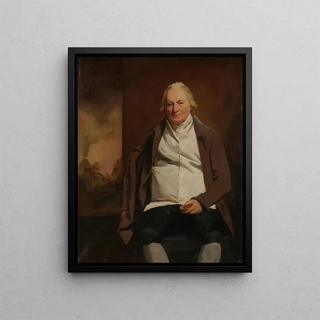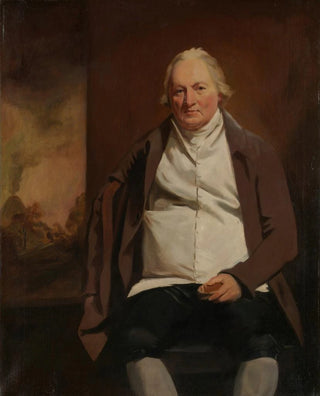Art print | John Gray 1731-1811 of Newholm - Sir Henry Raeburn


View from behind

Frame (optional)
In the vast panorama of art history, some works stand out for their ability to capture not only the appearance of an individual but also the very essence of their character. The art print John Gray 1731-1811 of Newholm - Sir Henry Raeburn is a perfect example. Created by Sir Henry Raeburn, a Scottish master of portraiture, this piece transcends a simple portrait to offer an immersion into the life and personality of its subject. John Gray, an iconic figure of his time, is depicted with such depth that one can almost feel the breath of his story. This work is much more than a mere representation; it is an open window to the past, an invitation to explore the subtleties of human identity through the lens of time.
Style and uniqueness of the work
Raeburn's style is characterized by an exceptional mastery of light and shadow, which gives his portraits an almost sculptural dimension. In the art print of John Gray, every brushstroke seems to dialogue with the light, illuminating the subject's face in a way that reveals his emotions and thoughts. The choice of colors, both rich and nuanced, contributes to the intimate atmosphere of the piece. Raeburn manages to create a subtle balance between realism and a certain idealization, allowing the viewer to feel an authentic connection with the character. The details, whether of the elegantly draped clothing or John Gray's pensive expression, testify to a meticulous attention to detail that elevates the work to a level of exception.
The artist and his influence
Sir Henry Raeburn, born in 1756 in Edinburgh, is one of the most influential portrait artists of 18th-century Scotland. His career, marked by a series of prestigious commissions, helped shape modern portraiture in Great Britain. Raeburn is distinguished by his ability to capture not only the physical appearance of his subjects but also their character, an aspect that was revolutionary in his time. By moving away from the rigid conventions of academic portraiture, he paved the way for a more personal and psychological approach to the art of portraiture.

Matte finish

View from behind

Frame (optional)
In the vast panorama of art history, some works stand out for their ability to capture not only the appearance of an individual but also the very essence of their character. The art print John Gray 1731-1811 of Newholm - Sir Henry Raeburn is a perfect example. Created by Sir Henry Raeburn, a Scottish master of portraiture, this piece transcends a simple portrait to offer an immersion into the life and personality of its subject. John Gray, an iconic figure of his time, is depicted with such depth that one can almost feel the breath of his story. This work is much more than a mere representation; it is an open window to the past, an invitation to explore the subtleties of human identity through the lens of time.
Style and uniqueness of the work
Raeburn's style is characterized by an exceptional mastery of light and shadow, which gives his portraits an almost sculptural dimension. In the art print of John Gray, every brushstroke seems to dialogue with the light, illuminating the subject's face in a way that reveals his emotions and thoughts. The choice of colors, both rich and nuanced, contributes to the intimate atmosphere of the piece. Raeburn manages to create a subtle balance between realism and a certain idealization, allowing the viewer to feel an authentic connection with the character. The details, whether of the elegantly draped clothing or John Gray's pensive expression, testify to a meticulous attention to detail that elevates the work to a level of exception.
The artist and his influence
Sir Henry Raeburn, born in 1756 in Edinburgh, is one of the most influential portrait artists of 18th-century Scotland. His career, marked by a series of prestigious commissions, helped shape modern portraiture in Great Britain. Raeburn is distinguished by his ability to capture not only the physical appearance of his subjects but also their character, an aspect that was revolutionary in his time. By moving away from the rigid conventions of academic portraiture, he paved the way for a more personal and psychological approach to the art of portraiture.






